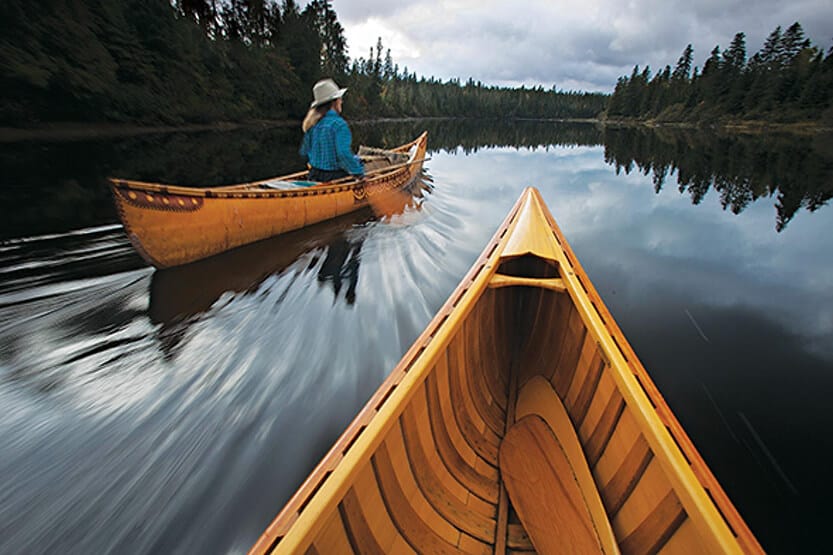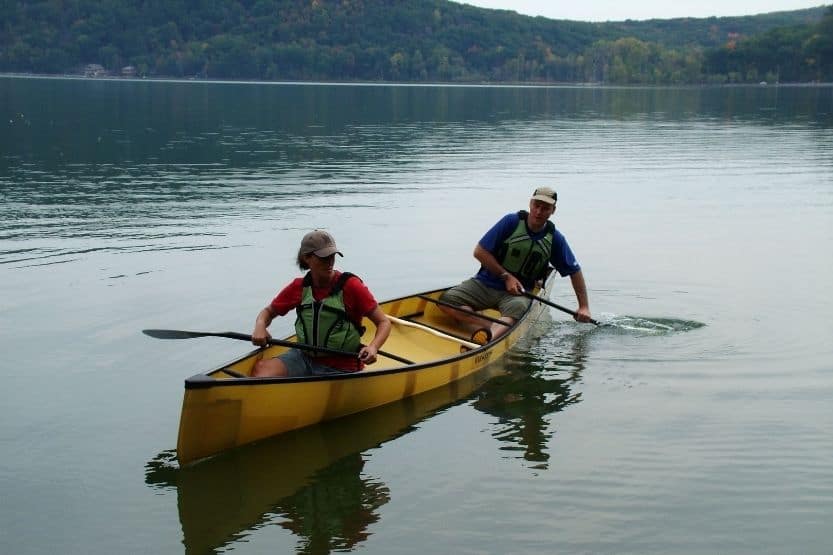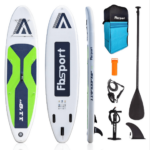Learning how to canoe might seem intimidating for a beginner, but it is just like learning how to bike. Once you learn the basics, you will have more enjoyable canoeing experiences. How to canoe?
To learn how to canoe properly, we will go over these 10 steps:
- Preparation
- Choosing the Correct Paddle
- Packing Items in the Canoe
- Getting in the Canoe
- Launching the Canoe
- Paddling the Canoe
- Steering the Canoe
- The Low Brace (Canoe Paddle Stroke)
- Landing and Getting Out
Each time you head out on the water, you will become more comfortable and confident with each step.
Read on to learn more about how to canoe properly, including how to paddle a canoe, how to steer a canoe, launching, landing, and more.
Also, to make your canoe trips more comfortable and enjoyable, take a look at the Woowave Kayak Seat Padded Deluxe Canoe Seat. This seat is ergonomic, durable, and comfortable, and easy to install and remove:
Click here to see it on Amazon.
How to Canoe
With the right equipment and by following the tips below, you’ll learn how to canoe in no time.

Here’s a detailed step-by-step guide on how you can learn how to canoe:
1. Preparation
Your ability to learn to canoe will be easier and faster if your first prepare yourself. What are the things that you need to prepare before jumping into the water?
- Plan your route and consider the portages and obstacles along the way;
- Tell family or friends about your route and when you plan to return;
- Get the weather forecast for the day for the place you are going to;
- Wear your personal floating device;
- Consider the temperature of the water and dress accordingly;
- Bring your smartphone for emergencies;
- Place all your stuff, including phones, in a waterproof container or bag;
- Cover your map with waterproofing materials;
- Bring a whistle to alert others during emergencies;
- Bring a throw bag rescue rope and an extra paddle;
- Ensure that there are buoyancy bags attached to your canoe;
- Don’t canoe at night. Bring navigation light if you need to;
- Don’t go into open waters. Wind and water can become dangerous in these places; and
- Pay attention to motorized boats.
2. Choosing the Correct Paddle
The typical paddle used in canoeing is the otter tail type. It is ideal for solo and flatwater canoeing. But there are other types that you can also use.
Paddles come in various shapes, sizes, and materials, just like canoes. These paddles have one single blade and pear-shaped or T-grip handles.
The majority of canoe enthusiasts prefer paddles made of wood. Wooden paddles are comfortable to use even after many hours of use. They also keep warm and natural, which is advantageous if you are out there in cold water.
The best paddles are light and strong. For long trips on flat water, choose a paddle that is long and narrow. Its grip should be pear-shaped since this is less stressful on your muscles and tendons.
For canoeing in whitewater or strong currents, use a narrow, wide blade with a T-grip handle. This grip will give you more catch and control of the paddling.
For an excellent canoe paddle, take a look at the BENDING BRANCHES Beavertail Canoe Paddle. This paddle has a durable, high-quality design and wood quality. It is lightweight and efficient in the water.
Click here to see it on Amazon.
3. Packing Items in the Canoe
By packing your canoe as close to the water as possible, you will be spared from the canoe’s heavy carrying to the launching spot. Place lighter items at the front and the back of the canoe.
The heavy items should be placed in the middle of the canoe. Pack them tightly and secure them under the seats to not shift or roll during the trip.
Food, clothing, and camping gear should be stored inside watertight containers or bags. It is better to distribute your stuff in several containers or bags rather than just one container.
This will ease your loading. And in case your canoe flips, you can easily fish them out of the water.
You must store the first aid kit somewhere it can be easily accessed. Maps, spare paddles, phones, and GPS should also be within easy reach.
4. Getting in the Canoe
If your launching point is on the shoreline, your partner should hold the canoe to steady it while you are getting in. If you are launching the canoe on the dock, tie both ends to the dock using a rope.
Before you can paddle your canoe, you must first get in it. As much as possible, you get in dry and not wet. The canoe should be on the water, parallel to the bank. With one end on the shore and one end on the water, the canoe can easily flip over.
Your sweet spot is at the center of the canoe. In getting in, you need to establish three points of contact and maintain them. This will stabilize the canoe using both your hands while stepping into the canoe’s centerline with your foot.
Put one hand on the closest gunwale and one foot in the center of the canoe. Bend low and hold the farthest gunwale with your other hand as you transfer your weight to your foot. Then place your other foot onto the canoe and then lower yourself by kneeling.
Keep that position until your partner gets on board, and then take your seat and assume your paddling position. The reverse of this procedure is what you will do when getting out of the canoe.
If you are doing it from the dock, your partner should kneel and hold the canoe while getting in. Then hold the dock so that your partner can get in. You should do the same if you’re getting in from a beach or shallow water.

5. Launching the Canoe
When you learn how to canoe, launching the canoe is an important step. If you are launching your canoe from the dock, untie it once you and your partner are inside. Slowly push the canoe off the dock with your paddle or your hand.
If you are launching the canoe from the shore, the sternman or the one at the back should push the canoe off the water as they are getting into the canoe.
The sternman should put one leg in the canoe and then push off the canoe with the other leg as they bring it inside the canoe.
6. Paddling the Canoe
The next step we will look at is how to paddle a canoe. The bowman and the sternman should paddle on opposite sides of the canoe to travel in a straight line and maintain stability. The frontman concentrates on paddling while the back man takes turns in paddling and steering.
Some ask how to row a canoe. However, paddling a canoe is different from rowing a canoe. Rowing requires attaching two blades to your canoe. Other requirements include a lower seat position at the center, the right size of high-quality oars, and lastly, a pair of oarlocks and sockets.
Take note that for a beginner, paddling a canoe is easier than rowing it.
You have to learn how to paddle a canoe. There are some basic paddling strokes that you need to learn. They are the following:
- Forward and backward paddling
- Drawing
- Prying
- Sweeping
- J-stroking
Note: The sternman or the person uses the last two strokes at the back of the canoe.
In forward paddling, you need to put your paddleboard ahead of you and dig it into the water. Then pull the paddle towards you and stop at your hip. Your arms should be almost straight. You will also use torso rotation rather than your shoulder and arm muscles.
That means your core performs the bulk of the work. The paddle should be almost vertical as it enters the water.
When you are the bowman, you can draw or pry to avoid hitting a rock or to pull into a dock. The same is also true with the sternman. You can draw by reaching out the paddle blade, which should be parallel to the canoe in the water.
Then pull the water towards you. Prying uses the same motions, but only in reverse, which means you need to push the water away from you.
7. Steering the Canoe
How to steer a canoe is one of the biggest challenges people have with canoeing. When you are paddling on the canoe’s right, a sweep will cause your canoe to turn to the left. If you are in a 2-person canoe, this steering responsibility mainly falls with the person in the back, the sternman.
Sweeping begins with the paddle almost straight in your front, just under that water surface. Then sweep the paddle blade in a semi-circle and finish at the back of the canoe.
In turning right, the sternman executes a j-stroke. The movement is actually a forward stroke combined with an outward pry-like flick at your back as you finish the stroke.
In other words, you start with a forward stroke and end it with a steering correction. It will get easier the more you practice this stroke.
In backward paddling, you are essentially doing the forward paddle in reverse. This stroke is useful in stopping the canoe and avoiding collisions with another boat or a stationary object.
8. The Low Brace (Canoe Paddle Stroke)
The ultimate stroke that you need to learn is the low brace. This is the stroke that you will execute when your canoe is about to capsize. Like the other strokes, the key to this stroke is your body movement. It is not the use of brute force.
In this stroke, you will have the back of the paddle blade on the water. The paddle shaft should be low and nearly horizontal. Your wrists should be straight and your elbows above the paddle shaft.

You will pull the canoe straight with rapid movements while the blade is resting on the water, providing the necessary support. Although it is a natural reaction, strive not to lift your head first out of the water. The canoe should be up first before your head.
9. Landing and Getting Out
If you want to land on the shore, steer the canoe so that its bow is pointed directly at the shoreline. When landing on a dock, maneuver the canoe so that its body is parallel to the side of the dock. Slow down the canoe as you approach your landing site.
Stabilize the canoe before trying to get out. If you are landing on a dock, tie the bow and the canoe’s stern to the dock using a rope. If you are landing on the shore, the bowman should get out first. Then the bowman should hold the canoe steady and help the sternman get out.
Best Canoe Accessories
To make your canoe trips more enjoyable, four of the best canoe accessories are as follows:
1. Woowave Kayak Seat Padded Deluxe Canoe Seat
To make your canoe trips more comfortable and enjoyable, take a look at the Woowave Kayak Seat Padded Deluxe Canoe Seat. This seat is comfortable, ergonomic, durable, and easy to install and remove:
Click here to see it on Amazon.
2. Bending Branches Beavertail Canoe Paddle
For an excellent canoe paddle, take a look at the Bending Branches Beavertail Canoe Paddle. This paddle has a durable, high-quality design and wood quality. It is lightweight and efficient in the water.
Click here to see it on Amazon.
3. Slide Anchor – Box Anchor for Offshore Anchoring – Includes Storage Bag
A compact, easy to use, and very strong anchor that is perfect for stopping to fish or take in the beauty.
Click here to see it on Amazon.
4. Wilderness Systems Helix PD Pedal Drive
If you get tired of paddling, use this effective pedal drive instead to move your canoe.
Click here to see it on Amazon.
Conclusion: How to Canoe
In order to learn how to canoe, including how to paddle and steer a canoe correctly, we looked at each of the following steps:
- Preparation
- Choosing the Correct Paddle
- Packing Items in the Canoe
- Getting in the Canoe
- Launching the Canoe
- Paddling the Canoe
- Steering the Canoe
- The Low Brace (Canoe Paddle Stroke)
- Landing and Getting Out
Learning to canoe is, in itself, an exciting journey. Once you learn the tricks, you will be taking trips on the water that will be very satisfying.
Knowing the ins and outs of canoeing will enable you to access places that others can’t reach. You will also discover the world from the water.
Don’t be afraid because there are no tippy canoes, only tippy paddlers. It is just like learning how to ride a bike for the first time. You won’t avoid tipping, but eventually, you will learn how to balance yourself and ride the canoe faster.
Before you can enjoy canoeing, you first have to learn it. Learning it might be challenging and sometimes overwhelming. There are terms like eddy and portaging that you need to know.
But when you have gone through all the beginning steps, a new and amazing world on the water will open up for you.
Now that you know the right equipment and the basics of how to canoe, it’s time for you to plan a canoeing trip with your family and friends.
Related reading:
Canoe in Illinois [Best 16 Places for Canoeing in Illinois]







![Boundary Waters Canoe Area Wilderness [Activities, Routes, Permits] boundary waters canoe area](https://boatinggeeks.com/wp-content/uploads/2021/07/boundary-waters-canoe-area-150x150.jpg)
![Read more about the article Canoe in Illinois [Best 16 Places for Canoeing in Illinois]](https://boatinggeeks.com/wp-content/uploads/2020/12/canoe-in-illinois-300x200.jpg)
![Read more about the article Best Canoe Paints [5 Top Picks]](https://boatinggeeks.com/wp-content/uploads/2021/03/canoe-paint-300x200.jpg)
![Read more about the article Kayak in Virginia [Best Places for Kayaking in Virginia]](https://boatinggeeks.com/wp-content/uploads/2020/12/kayaking-in-virginia-300x200.jpg)